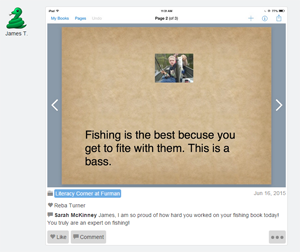 James, a third grader enrolled in a summer reading program, reluctantly joined his tutor each morning and often shrugged in response to questions or invitations to participate. Initial assessments revealed low self-perception and attitudes toward reading and writing and a lack of motivation and independence as a writer. James demonstrated difficulty with finding writing topics, engaging in the act of writing, and maintaining overall writing stamina. He was more interested in outdoor activities or playing games on his tablet.
James, a third grader enrolled in a summer reading program, reluctantly joined his tutor each morning and often shrugged in response to questions or invitations to participate. Initial assessments revealed low self-perception and attitudes toward reading and writing and a lack of motivation and independence as a writer. James demonstrated difficulty with finding writing topics, engaging in the act of writing, and maintaining overall writing stamina. He was more interested in outdoor activities or playing games on his tablet.
Using his interests in technology and the outdoors, his tutor encouraged him to take photos of his weekend fishing trip. She used these photos on his tablet to encourage discussion, and when asked what he wanted to write about, James chose fishing. Using Book Creator, he wrote an opinion and informational piece and then posted these pages in his Seesaw digital portfolio so his family could see his work. His mom “liked” it and left positive comments. Sharing his work on Seesaw gave James an authentic audience for his writing and made communication between home and school easier, which is an essential component of student success.
James used Seesaw throughout the tutoring sessions to reflect on his reading and writing progress and goals. Because James had difficulty with composing ideas in writing, his tutor provided him with sentence frames such as “As a reader/writer, I learned…” and “To continue to grow, I will…” to help initiate his self-evaluation and reflection process. James learned about the importance of continued practice as a reader and writer as noted in his reflection from June 30: “To continue to grow as a writer, I will keep writing.” The use of digital tools enhanced James’s engagement, interest, and attitude toward writing. According to his tutor, “Technology was definitely the [catalyst] that changed James’s view of writing!”
Digital portfolios
Digital portfolios can serve to demonstrate a wide range of purposes and processes including completed work or work in progress. Students can explain their thinking and request feedback from others to foster more authentic learning experiences. The online nature of digital portfolios makes it easy for both students and teachers to evaluate growth. Students can examine their strengths, set goals for areas of continued development, and take greater ownership in their own learning process. Additionally, stakeholders in students’ education such as parents and teachers can see ongoing evidence of students’ growth.
Seesaw is a versatile online tool that can be used for a range of self-assessment activities such as exit slips, reflection, and portfolios for goal setting and to document progress over time. Getting started with Seesaw is simple. Once a class has been created, students can sign in with e-mail addresses or by scanning a QR code from their devices, which is especially helpful if students do not have individual e-mail accounts. Once in the Seesaw class, students can upload images, texts, PDF files, links, videos, drawings, and work from other apps. Teachers must approve work before it can be posted, and parents can be invited to view their child’s work. With teacher approval, students can feature their work on the Seesaw blog to connect with wider audiences from around the world. Giving students a platform from which to share their work increases access to authentic audiences, which is an important part of any writing program.

 Katie Stover is an assistant professor of Education at Furman University in Greenville, SC, and coauthor of From Pencils to Podcasts: Digital Tools for Transforming K–6 Literacy Practices(Solution Tree, 2017) and Smuggling Writing: Strategies That Get Students to Write Every Day, in Every Content Area, Grades 3–12(Corwin, 2016). Lindsay Yearta is an assistant professor of Education at Winthrop University in Rock Hill, SC, and coauthor of From Pencils to Podcasts: Digital Tools for Transforming K–6 Literacy Practices(Solution Tree, 2017) as well as a number of articles published in peer-reviewed journals. She can be reached via Twitter.
Katie Stover is an assistant professor of Education at Furman University in Greenville, SC, and coauthor of From Pencils to Podcasts: Digital Tools for Transforming K–6 Literacy Practices(Solution Tree, 2017) and Smuggling Writing: Strategies That Get Students to Write Every Day, in Every Content Area, Grades 3–12(Corwin, 2016). Lindsay Yearta is an assistant professor of Education at Winthrop University in Rock Hill, SC, and coauthor of From Pencils to Podcasts: Digital Tools for Transforming K–6 Literacy Practices(Solution Tree, 2017) as well as a number of articles published in peer-reviewed journals. She can be reached via Twitter.